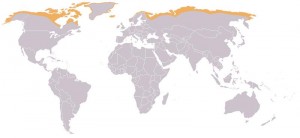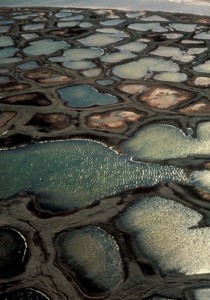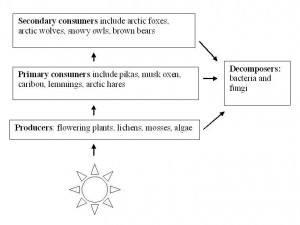What Animals And Plants Live In The Tundra
TUNDRA
The tundra is a biome characterized by an extremely cold climate, little precipitation, poor nutrients, and a short growing season. Other characteristics include low biodiversity, simple plants, limited drainage, and large variations in populations.
In that location are two types of tundra: arctic and alpine. Chill tundra is located in the Northern Hemisphere; alpine tundra is located at high elevations on mountains throughout the world. Tundra is also plant to a limited extent in Antarctica – specifically, the Antarctic Peninsula.
ARCTIC TUNDRA
Arctic tundra is found along the northern coasts of Due north America, Asia, and Europe, and in parts of Greenland. It extends due south to the border of the taiga (a biome characterized by coniferous forests). The division between the forested taiga and the treeless tundra is known every bit the timberline or tree line.

Location of arctic tundra across the Northern Hemisphere. Image courtesy of Wikimedia.
The tundra is known for cold weather condition, with an average wintertime temperature of -30 degrees F (-34 degrees C), and an boilerplate summer temperature ranging from 37 degrees to 54 degrees F (iii degrees to 12 degrees C). The growing season lasts from 50 to threescore days. The biome is also characterized past desertlike weather condition, with an average of six to ten inches (15 to 25 cm) of yearly precipitation, including snow melt. Winds oftentimes reach speeds of 30 to lx miles (48 to 97 km) an hour.
Another hallmark of the tundra is permafrost, a layer of permanently frozen subsoil and partially decayed organic thing. Just the meridian nine or ten inches of soil thaw, leading to the formation of bogs and ponds each spring.

Water ice wedges in the permafrost can crack and cause the formation of polygonal footing. This picture also illustrates the formation of ponds as the snowfall melts each spring. Photo courtesy of U.S. Fish and Wild fauna Service.
Tundra and taiga permafrost stores about one-third of the world's soil-bound carbon. Warming Arctic temperatures due to climate change are causing the permafrost to thaw, releasing the carbon in the form of carbon dioxide (a greenhouse gas). Boosted carbon dioxide in the temper will intensify warming, leading to increased thawing and the release of even more carbon dioxide. This positive feedback loop thus has the potential to significantly increase the rate and effects of climate change.
Approximately ane,700 species of vascular plants are found beyond the Arctic tundra, including flowering plants, low shrubs, sedges, grasses, and liverworts. Lichens, mosses, and algae are also mutual. In general, tundra plants are low growing, have shallow root systems, and are capable of carrying out photosynthesis at low temperatures and with low light intensities.
Animals found in the Arctic tundra include herbivorous mammals (lemmings, voles, caribou, arctic hares, and squirrels), cannibal mammals (chill foxes, wolves, and polar bears), fish (cod, flatfish, salmon, and trout), insects (mosquitoes, flies, moths, grasshoppers, and blackflies), and birds (ravens, snow buntings, falcons, loons, sandpipers, terns, and gulls). Reptiles and amphibians are absent-minded because of the extremely common cold temperatures. While many of the mammals have adaptations that enable them to survive the long common cold winters and to breed and enhance young quickly during the short summers, most birds and some mammals migrate south during the winter. Migration means that Chill populations are in continual flux.
A generalized nutrient spider web for the Arctic tundra begins with the various constitute species (producers). Herbivores (principal consumers) such as pikas, musk oxen, caribou, lemmings, and arctic hares make up the adjacent rung. Omnivores and carnivores (secondary consumers) such as arctic foxes, brown bears, arctic wolves, and snowy owls top the web. Bacteria and fungi play the important office of breaking down organic matter and returning nutrients to the soil for re-use. Of course, the exact species involved in this spider web vary depending on the geographic location.

A generalized tundra food web. Exact relationships and species depend on geographic location.
The interconnected nature of a food web means that as numbers of i species increase (or subtract), other populations change in response. An ofttimes-discussed tundra example is the lemming population. Lemmings are small rodents that feed on plants. Populations of lemmings fluctuate radically (from big populations to well-nigh extinction) in regular intervals. While scientists believed that populations of lemming predators (foxes, owls, skuas, and stoats) as well fluctuated in response to these changes, there is now evidence that suggests that the predators themselves drive the changes in lemming populations.
Climatic change is affecting tundra ecosystems in many ways. Thawing permafrost not only releases carbon dioxide but likewise leads to coastal erosion– an increasing trouble in Alaska where villages are at adventure. Warming also means that seasons are arriving before – a shift not only in temperatures but also in the emergence and flowering of plants. Biologists suspect that a mismatch between institute availability and calving is increasing mortality rates of caribou calves. Finally, species distributions may change as birds and other animals shift their range or migration patterns in response to irresolute temperatures.
ANTARCTIC TUNDRA
Much less extensive than Arctic tundra, Antarctic tundra is found on the Antarctic Peninsula and several Antarctic and subantarctic islands. These areas have rocky soil that supports minimal plant life: two angiosperm species, mosses, algae, and lichens. Antarctic tundra does non support mammals, simply marine mammals and birds inhabit areas near the coast. All species in Antarctica and the Antarctic Islands (southward of lx degrees S latitude) are protected past the Antarctic Treaty.
LINKS
The Earth's Biomes
An overview of biomes and information on vi major types: freshwater, marine, desert, wood, grassland, and tundra.
Biomes and Ecosystems
General information about biomes and ecosystems, with links to pages about tundra, taiga, temperate woods, tropical rainforest, desert, grassland, and body of water biomes. This site may as well be used with upper-unproblematic students.
Geography4Kids: Biosphere
Includes pages on environmental, ecosystems, food chains, populations, and state biomes. Advisable for use with upper-uncomplicated students.
NATIONAL SCIENCE EDUCATION STANDARDS: Scientific discipline CONTENT STANDARDS
The entire National Science Education Standards certificate tin be read online or downloaded for free from the National Academies Press web site. The following excerpt was taken from Chapter six.
Pedagogy about biomes (including the tundra) tin can meet a wide variety of cardinal concepts and principles, including:
K-4 Life Scientific discipline
The Characteristics of Organisms
- Organisms have basic needs. For example, animals need air, water, and food; plants require air, water, nutrients, and light. Organisms can survive only in environments in which their needs tin exist met. The world has many different environments, and distinct environments support the life of different types of organisms.
Organisms and their Environments
- All animals depend on plants. Some animals consume plants for food. Other animals eat animals that swallow the plants.
- An organism's patterns of behavior are related to the nature of that organism's environment, including the kinds and numbers of other organisms present, the availability of food and resources, and the physical characteristics of the surroundings. When the surroundings changes, some plants and animals survive and reproduce, and others die or move to new locations.
- All organisms cause changes in the environment in which they live. Some of these changes are detrimental to the organism or other organisms, whereas others are beneficial.
- Humans depend on their natural and synthetic environments. Humans change environments in ways that can be either beneficial or detrimental for themselves and other organisms.
Thousand-4 Science in Personal and Social Perspectives
Changes in Environments
- Environments are the space, conditions, and factors that affect an private's and a population's ability to survive and their quality of life.
- Changes in environments tin can be natural or influenced past humans. Some changes are adept, some are bad, and some are neither good nor bad. Pollution is a change in the environment that tin can influence the health, survival, or activities of organisms, including humans.
- Some environmental changes occur slowly, and others occur rapidly. Students should understand the dissimilar consequences of irresolute environments in small increments over long periods as compared with changing environments in large increments over brusque periods.
5-8 Life Scientific discipline
Populations and Ecosystems
- A population consists of all individuals of a species that occur together at a given place and fourth dimension. All populations living together and the physical factors with which they interact compose an ecosystem.
- Populations of organisms can be categorized by the office they serve in an ecosystem. Plants and some microorganisms are producers – they make their ain food. All animals, including humans, are consumers, which obtain food by eating other organisms. Decomposers, primarily bacteria and fungi, are consumers that utilise waste materials and dead organisms for food. Food webs identify the relationships amidst producers, consumers, and decomposers in an ecosystem.
- For ecosystems, the major source of energy is sunlight. Free energy entering ecosystems as sunlight is transferred by producers into chemical energy through photosynthesis. That free energy and so passes from organism to organism in nutrient webs.
- The number of organisms an ecosystem can back up depends on the resources available and abiotic factors, such every bit quantity of light and h2o, range of temperatures, and soil composition. Given adequate biotic and abiotic resource and no disease or predators, populations (including humans) increase at rapid rates. Lack of resource and other factors, such as predation and climate, limit the growth of populations in specific niches in the ecosystem.
5-8 Scientific discipline in Personal and Social Perspectives
Populations, Resource, and Environments
- When an area becomes overpopulated, the environment volition become degraded due to the increased use of resource.
- Causes of ecology deposition and resource depletion vary from region to region and from country to country.
Natural Hazards
- Internal and external processes of the world system cause natural hazards, events that modify or destroy human and wildlife habitats, impairment holding, and harm or impale humans. Natural hazards include earthquakes, landslides, wildfires, volcanic eruptions, floods, storms, and fifty-fifty possible impacts of asteroids.
- Man activities also can induce hazards through resources acquisition, urban growth, land-utilize decisions, and waste disposal. Such activities can accelerate many natural changes.
This article was written by Jessica Fries-Gaither. For more information, meet the Contributors folio. Email Kimberly Lightle, Principal Investigator, with whatever questions virtually the content of this site.
Copyright March 2009 – The Ohio Country University. This material is based upon work supported past the National Scientific discipline Foundation under Grant No. 0733024. Whatever opinions, findings, and conclusions or recommendations expressed in this fabric are those of the author(s) and do not necessarily reflect the views of the National Science Foundation. This work is licensed nether an Attribution-ShareAlike 3.0 Unported Creative Commons license .
Source: https://beyondpenguins.ehe.osu.edu/issue/tundra-life-in-the-polar-extremes/life-in-the-tundra
Posted by: rodriguezrecke1963.blogspot.com

0 Response to "What Animals And Plants Live In The Tundra"
Post a Comment